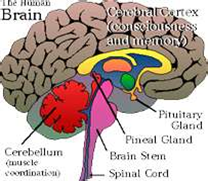Adrenal
glands
Adrenal
glands are a pair of ductless glands
located above the kidneys. Through hormonal secretions, the adrenal glands
regulate many essential functions in the body, including biochemical balances
that influence athletic training and general stress response.
The glucocorticoids include corticosterone, cortisone,
and hydrocortisone or cortisol. These hormones serve to stimulate the
conversion of amino acids into carbohydrates which is a process known as
gluconeogenesis, and the formation of glycogen by the liver.
They also stimulate the formation
of reserve glycogen in the tissues, such as in the muscles. The glucocorticoids
also participate in lipid and protein metabolism. The cortex of the adrenal gland is known
to produce over 20 hormones, but their study can be simplified by classifying
them into three categories: glucocorticoids, mineralcorticoids, and sex
hormones.
They are triangular-shaped glands
located on top of the kidneys. They produce hormones such as estrogen,
progesterone, steroids, cortisol, and cortisone, and chemicals such as
adrenalin (epinephrine), norepinephrine, and dopamine. When the glands produce
more or less hormones than required by the body, disease conditions may occur.
The adrenal cortex secretes at
least two families of hormones, the glucocorticoids and mineral corticoids. The adrenal
medulla secretes the hormones epinephrine (adrenalin) and norepinephrine (noradrenalin).
Adrenal
Cortex:
The hormones made by the Adrenal
Cortex supply long-term responses to stress. The two major hormones produced
are the Mineral
Corticoids and the Glucocorticoids. The Mineral Corticoids regulate
the salt and water balance, leading to the increase of blood volume and blood
pressure.
The Glucocorticoids are monitoring the ACTH, in turn
regulating carbohydrates, proteins, and fat metabolism. This causes an increase in blood glucose. Glucocorticoids also reduce the
body's inflammatory response.
Cortisol is one of the most active
glucocorticoids.
It usually reduces the effects of inflammation or swelling throughout the body.
It also stimulates the production of glucose from fats and proteins, which is a
process referred to as gluconeogenesis.
Aldosterone is one example of a
mineralcorticoid. It signals the tubules in the kidney nephrons to reabsorb
sodium while secreting or eliminating potassium. If sodium levels are low in the
blood, the kidney secretes more renin,
which is an enzyme that stimulates the formation of angiotensin from a molecule made from the
liver. Angiotensin stimulates aldosterone secretion. As a result, more sodium
is reabsorbed as it enters the blood.
Aldosterone, the major mineralcorticoid,
stimulates the cells of the distal convoluted tubules of the kidneys to
decrease re-absorption of potassium and increase re-absorption of sodium. This in turn leads to an increased
re-absorption of chloride and water. These hormones, together with such
hormones as insulin and glucagon, are important regulators of the ionic
environment of the internal fluid.
The renin-angiotensin-aldosterone
mechanism can raise blood pressure if it tends to drop. It does this in two ways.
Angiotensin is a vasoconstrictor, decreasing the diameter of blood vessels. As
vessels constrict, blood pressure increases. In addition, as sodium is
reabsorbed, the blood passing through the kidney becomes more hypertonic. Water
follows the sodium into the hypertonic blood by osmosis. This increases the
amount of volume in the blood and also increases the blood pressure.
Sumber : Bpk. Dr. Iskandar Zulkarnain
#posting tugas cyberprenership
ahmad baihaqi
NIM 1112503964


































